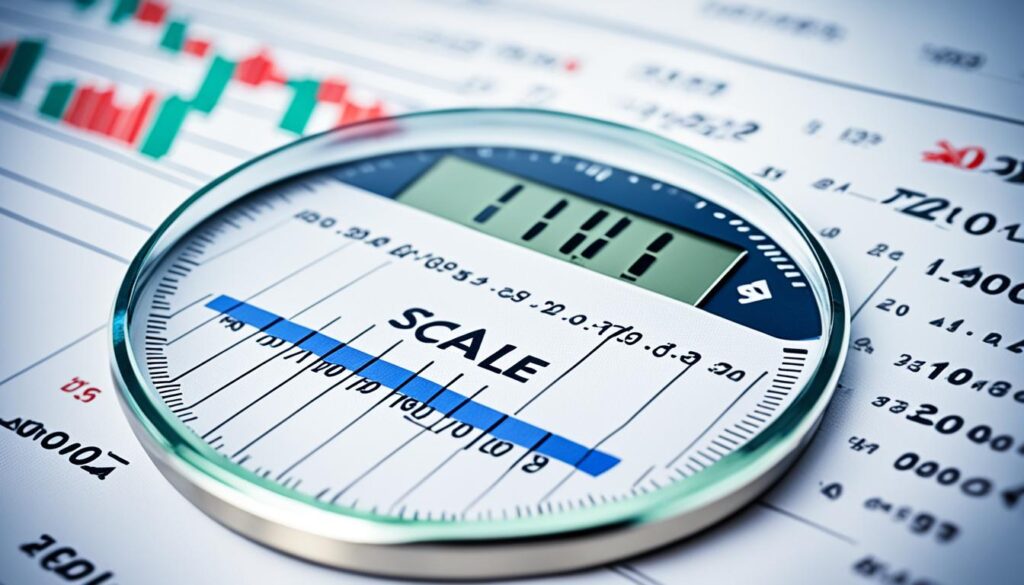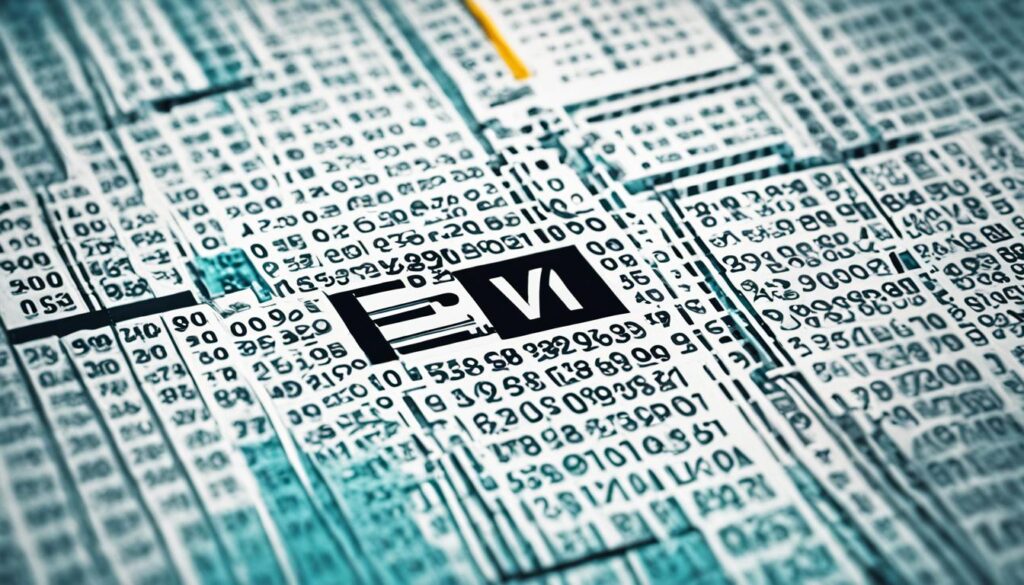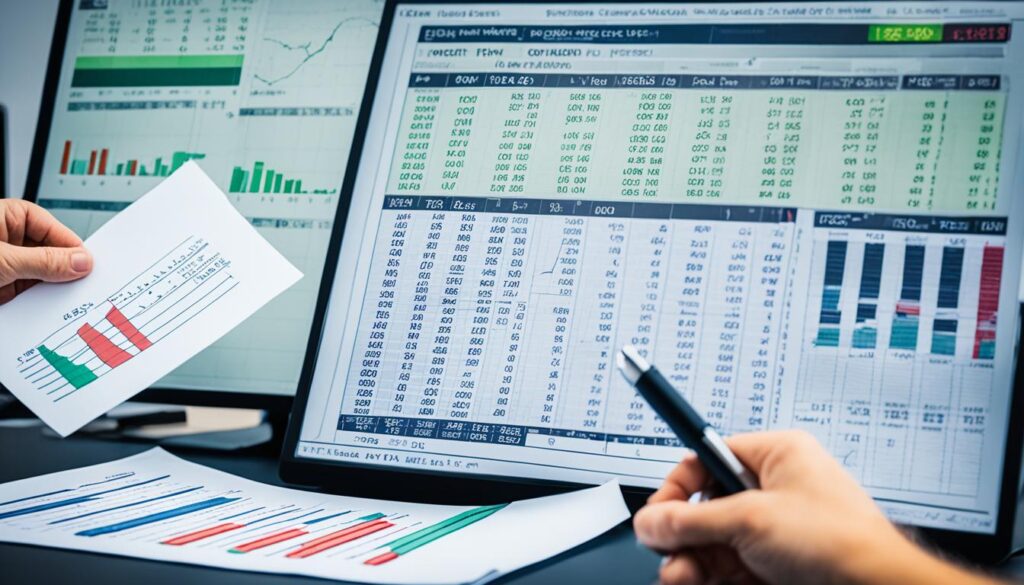What is a Lot in Forex Trading
In Forex trading, a standard lot means you’re dealing with 100,000 units of currency. This amount is huge! It’s important to grasp what a “lot” is when you trade currencies. It’s like buying eggs by the carton. Lots help you trade in fixed amounts, simplifying how you handle your trades.
A tiny change in a currency pair’s price can mean big money moves. In the EUR/USD pair, a single pip’s shift equals ten dollars in a standard lot trade. Yet, you can choose to trade in smaller lots too. Mini, micro, or nano lots make it easier to adjust your risk and trade size, fitting different strategies and budgets.
Want to go deeper into the world of trading lots? Let’s explore why lots are so crucial in Forex.
Key Takeaways
- A standard lot in Forex trading equals 100,000 units of the base currency.
- Mini lots consist of 10,000 units, micro lots contain 1,000 units, and nano lots have 100 units.
- Understanding the standardization of lot sizes helps traders effectively manage trading volume and position sizing.
- One pip movement in a standard lot is generally worth $10, affecting potential profit or loss.
- Different lot sizes allow traders to tailor their risk exposure and financial impact based on their strategies.
Introduction to Forex Trading Lots
Forex trading involves buying and selling lots of currency. It’s important to know the sizes of lots in Forex trading for good position size and risk management. These include standard, mini, micro, and nano lots. They fit different risk levels and strategies.
A standard lot is the biggest, with 100,000 units. It offers big profits but comes with more risk. Mini lots have 10,000 units, which is less risky but still active in the market. Micro lots have 1,000 units, and nano lots have only 100 units. They’re good for learning and cutting down on risks.
It’s key for traders to know how lot sizes affect trading volume. Adjusting lot sizes based on your risk tolerance and the market is critical. Using mini or micro lots can lower the risk of big losses. This also helps traders gain more experience.
The lot size you pick should match your trading plan and how much money you have. Since Forex markets can change a lot, using different lot sizes helps manage risk well. This keeps the balance between risk and reward.
| Lot Size | Unit Quantity | Risk Level | Trader Type |
|---|---|---|---|
| Standard Lot | 100,000 units | High | Experienced |
| Mini Lot | 10,000 units | Medium | Retail |
| Micro Lot | 1,000 units | Low | Novice |
| Nano Lot | 100 units | Minimal | Beginner |
To choose the right lot in Forex trading, you must understand how lot sizes influence risk and trading strategy. Matching the lot size to your strategy and risk level makes trading in the Forex market less risky. This approach gives traders more confidence in a fast-changing market.
Types of Forex Trading Gold Lots
In forex trading, knowing about forex lot sizes is key. The forex market deals with over $5 trillion a day. So, getting your lot size right is very important. There are four main types to understand: Standard lots, Mini lots, Micro lots, and Nano lots.
Standard Lots
A standard lot is 100,000 units of the base currency. It’s mainly for traders with a lot of money. Let’s say you trade a standard lot of EUR/USD. You need a minimum of about $11,485 with 1:100 leverage. Each pip is worth around $10 on EUR/USD trades, leading to big wins or losses.
Mini Lots
Like the name suggests, mini lots are smaller. They are 10,000 units of the base currency. They are great for lowering risk while still trading at a good volume. If you trade a mini lot of EUR/USD, you need at least $1,148.50 with a 1:100 leverage. A pip is worth $1, making it less risky than standard lots but offering good experience.
Micro Lots
Micro lots are even smaller. They are 1,000 units of the base currency. It’s good for new traders with its lower risk. For EUR/USD, trading a micro lot needs about $114.85 with a 1:100 leverage. Each pip is worth $0.10. This makes trading possible without a big starting budget.
Nano Lots
The nano lots are the smallest and least risky. Each lot is 100 units of the base currency. It’s great for strategy testing or those with little money to start. A pip with nano lots is worth only $0.01. This way, you can join the market with very low risks.
| Lot Type | Units | EUR/USD Pip Value | Minimum Deposit (assuming 1:100 leverage) |
|---|---|---|---|
| Standard Lot | 100,000 | $10 | $11,485 |
| Mini Lot | 10,000 | $1 | $1,148.50 |
| Micro Lot | 1,000 | $0.10 | $114.85 |
| Nano Lot | 100 | $0.01 | Less than $114.85 |
It’s important to pick the right lot size for your forex trading. Your risk tolerance and strategy determine the best size for you. Choosing between standard lots, mini lots, micro lots, and nano lots can make a big difference in your trades.
Understanding Standard Lots in Forex
In Forex trading, a standard lot equals 100,000 units of the base currency. It’s a large amount used by those with experience. Knowing about standard lots is key to navigating the forex market.
Take EUR/USD for example. Trading a standard lot of it means you are moving 100,000 units. This big amount affects the value of a pip. With EUR/USD, each pip is worth about $10. It shows why having a strong trading strategy is important for risk management.
Traders can choose lot sizes based on their funds and how much risk they want to take. Apart from standard lots, there are mini lots, micro lots, and nano lots. These smaller sizes help reduce risk before jumping into big trades.
Trading conditions are also affected by things like leverage and rules set by the broker. Brokers might allow trading with smaller lot sizes. This gives more flexibility to traders, especially those starting with low funds.
Understanding standard lots and how they relate to pip values is vital. Using standard lots wisely in your strategy can lead to better profit and loss management. It’s crucial for success in the forex market.
| Lot Size | Units |
|---|---|
| Standard Lot | 100,000 |
| Mini Lot | 10,000 |
| Micro Lot | 1,000 |
| Nano Lot | 100 |
Role of Mini Lots in Trading
Mini lots are key in the forex market. They make it easier for traders to get in, especially those starting out. A mini lot is 10,000 units of the base currency, much smaller than a standard lot.
Mini lots are perfect for managing risk better. They help traders deal with market changes without using a lot of money. It’s smart to only risk a small percentage of your account on each trade. Mini lots are a great option for many traders because they are in between bigger and smaller lot sizes.

They allow traders to increase or decrease risk more carefully, not needing a big investment. A single mini lot is worth around $11,000, whereas a standard lot is valued at $110,000.
| Lot Type | Units of Base Currency | Approximate Value | Pip Value (EUR/USD) |
|---|---|---|---|
| Standard Lot | 100,000 | $110,000 | $10 |
| Mini Lot | 10,000 | $11,000 | $1 |
| Micro Lot | 1,000 | $1,000 | $0.10 |
| Nano Lot | 100 | $110 | $0.01 |
In short, mini lots are the perfect middle ground for many traders. They strike a good balance of risk and reward, making them an appealing choice for those working their way up in forex trading.
What Micro Lots Mean for Traders
Micro lots are 1,000 currency units, making them perfect for beginner traders. They allow new traders to dip into the forex market with a small investment. Start with $100 to $500 and learn while keeping risk lower.
A EUR/USD trade with a micro lot sees each pip movement as $0.10. This means precise trade management and more flexibility.
Use Case for Micro Lots
They’re ideal for those starting out, wanting to test the market without risking big money. Use micro lots to try different trading strategies or learn how to manage trades effectively. With about 2:1 lower leverage, even a $500 account can handle a 1,000-unit micro lot trade.
Advantages of Micro Lots
- Lower leverage means you can make smaller trades and limit how much money you put at risk.
- Perfect for beginner traders who want to start small and learn with little risk.
- A good way to understand market changes and how to manage risk.
- Let you spread out your trading to reduce risk through diversification.
| Unit Type | Unit Size | Pip Value |
|---|---|---|
| Standard Lot | 100,000 units | $10 |
| Mini Lot | 10,000 units | $1 |
| Micro Lot | 1,000 units | $0.10 |
| Nano Lot | 100 units | $0.01 |
Nano Lots: Trading for Beginners
Nano lots are the smallest forex trading lot, with just 100 units of currency. They are great for new traders with small accounts or limited money. This makes nano lots perfect for those starting out in forex, as they allow trading with low financial risk.

One of the main benefits of nano lots is their low risk. Trading with them means low potential gains and losses. For example, a 100-pip move with nano lots changes your profit by only $1.
Forex nano accounts are affordable, ranging from $5 to $50. They let traders work with small amounts, helping with learning and risk management. This means new traders can control their risk easily.
With nano lots, traders can test strategies with little money at risk. A $10 trade with the right leverage could make or lose only a few cents. This is perfect for new or careful traders who want to learn without risking a lot.
- Standard Lot: 100,000 units of currency
- Mini Lot: 10,000 units of currency
- Micro Lot: 1,000 units of currency
- Nano Lot: 100 units of currency
The EUR/USD pip cost changes with lot sizes, as shown below:
| Lot Size | Units of Currency | Cost Per Pip |
|---|---|---|
| Standard Lot | 100,000 | $10 |
| Mini Lot | 10,000 | $1 |
| Micro Lot | 1,000 | $0.10 |
| Nano Lot | 100 | $0.0001 |
Brokers like Oanda, IG, and more offer nano lots. For beginners, starting with nano lots is smart. It helps with risk management and builds confidence. As traders learn and grow, they can move up to bigger trades.
How Lot Size Affects Leverage
Understanding leverage in forex trading starts with lot size. The size you choose affects how much you put at risk, and your broker’s margin rules. A big lot size means you need more cash upfront and market changes can hit your account harder.
Imagine you can start with $300 and borrow 1000 times this amount. So, even with small cash, you can make or lose a lot. The Roadmap plan fits investments from $300 to $500,000. This makes it good for many starting levels.
Look at how various plans change your financial risk and profits each month:
| Plan | Minimum Deposit | Monthly Fee | Profit Range |
|---|---|---|---|
| Basic Plan | $300 | $17 | 5% – 12% |
| Premium Plan | $1,000 | 0.7% | 10% – 25% |
| Luxury Plan | $10,000 | 0.5% | 20% – 35% |
Using leverage wisely can bring big profits. But there are big risks. The highest big loss seen yet was 30%. Brokers like Exness, LiteFinance, CXM, and Pepperstone offer good tools for control.
Knowing about margin and leverage is key to smart lot size picking. Understanding the risk and reward, whether you start small or big, is essential. This knowledge helps keep trading successful.
Calculating Pip Value by Lot Size
To trade forex well, knowing how to calculate pip values for various lot sizes is key. Pip values differ for standard, mini, micro, and nano lots. Each type affects how much you can gain or lose, so it’s crucial to grasp these differences.

Standard Lot Pip Values
A standard lot is 100,000 units of the base currency. For major pairs, a pip is usually worth about $10. So, if you trade EUR/USD, a 1-pip change moves your profit or loss by $10. For currencies like USD/JPY, it’s calculated differently based on the exchange rate.
Mini Lot Pip Values
Mini lots are 10,000 units of the base currency. Each pip is worth around $1 in these trades. So, in EUR/USD, a 1-pip move shifts your account by $1. It’s a smaller amount, which helps traders control their risks better.
Micro Lot Pip Values
With just 1,000 units of the base currency, micro lots offer even lower risk. A pip is valued at $0.10 in this case. If you trade EUR/USD, a 1-pip change affects your account by a dime. This is good for staying involved in the market with less risk.
Nano Lot Pip Values
For the least amount of risk, there are nano lots, each with 100 units of the base currency. In this case, a pip equals just $0.01. It’s a great way to start in forex trading without risking too much. With EUR/USD, a 1-pip movement changes your account by only $0.01.
Lot in Forex Trading: How It Impacts Risk Management
In forex trading, your lot size choice is key to managing risk well. Before you pick a size, think about how much risk you can handle and the size of your account. The lot size you choose really affects how much you might lose on a trade.
There are different lot sizes in forex, and each one has its own level of risk and reward:
| Lot Type | Units | Risk Level |
|---|---|---|
| Standard Lot | 100,000 | High |
| Mini Lot | 10,000 | Moderate |
| Micro Lot | 1,000 | Low |
| Nano Lot | 100 | Very Low |
Bigger lots, like standard and mini, can bring in large profits but also have more risk. Smaller lots, like micro and nano, are for careful traders. They want to protect their money and not take big losses.
Choosing the right lot size is good for your account’s steady growth. It helps you avoid getting too emotional and keeps you disciplined. The correct lot size means you’re less likely to make quick, bad choices. It helps keep your trading mind in a good place.
Determining the Right Lot Size for Your Trades
Choosing the correct lot size in forex trading is key to your success. It helps you meet your goals and maintains a balanced strategy. You need to think about your risk level, what you want to achieve, and the current market.
Are you just starting? Use micro lots of 1,000 units. They’re great for learning because they cut down the risk. Once you’re more comfortable, try mini lots. They’re 10,000 units, about $1.00 for every pip with dollar-based pairs. Start with at least $2,000 in your account for this level.
Advanced traders might like standard lots, which are worth 100,000 units or $100,000 in trades. They can bring in big returns but have more risk. Be careful, big lot sizes can still move your account a lot, even with small pip changes.

It’s crucial to balance your lot sizes with your trading account’s size. This helps keep your money safe and your emotions in check. Like Mark Douglas says, the right lot size is like making sure a bridge stays stable. It stops you from making rash trades.
Stop Loss levels are also super important. They keep your risk the same no matter how big your position is. Most traders only risk about 1% of their account’s total worth per trade. This approach is about staying smart and disciplined.
| Lot Size | Units | Recommended for | Minimum Account Size | Risk Tolerance |
|---|---|---|---|---|
| Micro Lots | 1,000 | Beginners | Any (Lower Risk) | Low |
| Mini Lots | 10,000 | Intermediate Traders | $2,000+ | Moderate |
| Standard Lots | 100,000 | Professional Traders | $100,000+ | High |
Understanding pip value is critical for your success in trading. It directly affects your equity. Keep these points in mind to reach your goals safely.
Margin Requirements by Lot Size
Margin requirements are key in forex trading. They determine how much equity you need for your trades. It’s important to know this for different lot sizes. It affects the way you trade and the level of risk you take.
Standard Lot Margin Requirements
Standard lots are 100,000 units. Margin needs change with leverage. With 1:100 leverage, you’d need 1% of the trade value as equity. For a $100,000 trade, that’s $1,000.
If market risk is high, like on weekends, this might go up to 2%.
Mini Lot Margin Requirements
Mini lots have 10,000 units. The 1:100 leverage means you need 1% as your equity, which is $100. If over the weekend the requirement goes to 2%, you need $200.
Micro Lot Margin Requirements
Micro lots are 1,000 units. With 1:100 leverage, you’d just need $10. This can go up if the market gets more risky. Then you’d have to put more into your account.
Nano Lot Margin Requirements
Nano lots have 100 units. If you have a 1:100 leverage, you’d need about $1. But, if things get really volatile, you might need to add more.
| Lot Size | Units | Leverage Ratio | Margin Requirement (%) | Required Margin ($) |
|---|---|---|---|---|
| Standard Lot | 100,000 | 1:100 | 1% | $1,000 |
| Mini Lot | 10,000 | 1:100 | 1% | $100 |
| Micro Lot | 1,000 | 1:100 | 1% | $10 |
| Nano Lot | 100 | 1:100 | 1% | $1 |
Conclusion
Forex lot sizes are key in any Forex trading plan. Choosing the correct lot size is important. You might pick a lot of 100,000 units, 10,000 units, 1,000 units, or 100 units. This choice depends on what you want to achieve and how much risk you’re willing to take. Knowing this helps you manage your risks well and improve your trading results.
It’s also vital to know how lot sizes, leverage, and pip values work together. Leverage lets you control trades much bigger than your actual cash. It can boost both your wins and your losses. To handle these risks, it’s crucial to use stop-loss orders and not risk more than 1-2% of your trading account on a single trade.
To become really good at Forex trading, keep learning about different lot sizes. This learning helps you adjust your trading strategy to match your style and the market conditions. With this information, you can better understand and succeed in the Forex market.
